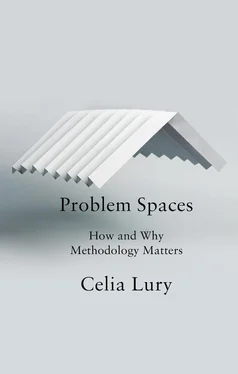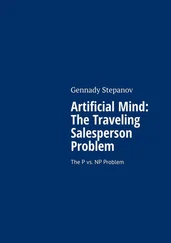1 Title page Problem Spaces How and Why Methodology Matters Celia Lury polity
2 Copyright page Copyright page Copyright © Celia Lury 2021 The right of Celia Lury to be identified as Author of this Work has been asserted in accordance with the UK Copyright, Designs and Patents Act 1988. First published in 2021 by Polity Press Polity Press 65 Bridge Street Cambridge CB2 1UR, UK Polity Press 101 Station Landing Suite 300 Medford, MA 02155, USA All rights reserved. Except for the quotation of short passages for the purpose of criticism and review, no part of this publication may be reproduced, stored in a retrieval system or transmitted, in any form or by any means, electronic, mechanical, photocopying, recording or otherwise, without the prior permission of the publisher. ISBN-13: 978-1-5095-0793-1 (hardback) ISBN-13: 978-1-5095-0794-8 (paperback) A catalogue record for this book is available from the British Library. Typeset in 11 on 13pt Sabon by Fakenham Prepress Solutions, Fakenham, Norfolk NR21 8NL Printed and bound in Great Britain by TJ International Limited The publisher has used its best endeavours to ensure that the URLs for external websites referred to in this book are correct and active at the time of going to press. However, the publisher has no responsibility for the websites and can make no guarantee that a site will remain live or that the content is or will remain appropriate. Every effort has been made to trace all copyright holders, but if any have been overlooked the publisher will be pleased to include any necessary credits in any subsequent reprint or edition. For further information on Polity, visit our website: politybooks.com
3 Acknowledgements Acknowledgements I would like to thank colleagues, friends and family near and far, including: Nerea Calvillo, Sophie Day, Michael Dieter, Sarah Doughty, Elena Esposito, Carolin Gerlitz, Christina Hughes, Eva Lash, Adam Lury, Giles Lury, Karen Lury, Henry Mainsah, Noortje Marres, Greg McInerny, Mike Michael, João Porto de Albuquerque, Maria Puig de la Bellacasa, Shirin Rai, Matt Spencer, David Stark, Martín Tironi, Nigel Thrift, Philipp Ulbrich, Matías Valderrama, Sylvia Walby, Naomi Waltham-Smith and Scott Wark. Special thanks go to Michael Castelle, who first introduced me to the idea of problem spaces; to Emma Uprichard, who kept me going; to Nate Tkacz and the three anonymous reviewers who read and commented on a draft of the book; and to Ana Gross, the co-author of Chapter 3 . I would also like to thank Karina Jákupsdóttir and Jonathan Skerrett at Polity for their patience and support. Research for this monograph was supported by an ESRC Professorial Fellowship: Order and Continuity: Methods for Change in a Topological Society, Ref No: 978-1444339598. I am grateful for this support.
4 Introduction: The Compulsion of Composition Introduction: The Compulsion of Composition Power is the compulsion of composition … The essence of power is the drive towards aesthetic worth for its own sake. All power is a derivative from this fact of composition attaining worth for itself. There is no other fact. Power and importance are aspects of this fact. It constitutes the drive of the universe. It is efficient cause, maintaining its power of survival. It is final cause, maintaining in the creature its appetition for creation. Alfred North Whitehead (1968: 119) Ann Kelly and Lynsey McGoey (2018) suggest that we are witnessing the emergence of ‘a new empire of truth’. Describing the significance of profound transformations in the ‘scaling, pace and symbolic power of fact-making’ for ‘the shifting relationships between knowledge, ignorance and power today’, they ask: What constitutes authoritative evidence in this political climate? To what uses is evidence put, and what values does it carry? What obligations must be placed on the companies, such as Google or Facebook, that configure our new public spheres while profiting from the tracking and steering of online behaviour? What counts in the making of facts, and who does the counting? Which empirical tools and metrics garner sufficient political capital to guide policy during times of economic uncertainty? And, critically, how do the social sciences respond to the increasing social and political significance of data while accounting for the deepening popular scepticism of the facts that data are used to support? (2018: 2–3) This book develops the thesis that to understand this new empire of truth and answer the questions Kelly and McGoey pose, a new concept of a problem space is needed.
So, what is a problem space? Compositional methodology Becoming topological The structure of the book Some general comments Notes
5 Part I Problem Spaces
6 1 What is a Problem Space? Approach 1: Dewey Approach 2: Simon The times of problem spaces Thinking context Approach 3: Haraway Approach 4: Jullien The methodological potential of the situation Approach 5: Appadurai Across Notes
7 Part II The Epistemic Infrastructure
8 2 The Parasite and the Octopus 1. Explicitation and literalization 2. Representation, semiotics and cognition 3. Observing the observed 4. The geo-politics of methodology 5. (Non-)Representation and/or participation Conclusion Notes
9 3 Indexing the Human (with Ana Gross) Indicators of price Platformization Notes
10 4 Platforms and the Epistemic Infrastructure Platformization 1. The architectural 2. The political 3. The computational 4. The figurative Conclusion Notes
11 Part III Compositional Methodology
12 5 More than Circular From model systems to platforms: the case of classification Double trouble 1. The natively artificial character of the empirical 2. The ontological multiplicity of the epistemological object Transcontextualism Conclusion Notes
13 6 Know-ability and Answer-ability The internalization of science? Interface effects Know-ability Interface control Answer-ability Conclusion Notes
14 Conclusion: How and Why Methodology Matters Notes
15 References Artwork
16 Index
17 End User License Agreement
1 Cover
2 Contents
3 1 What is a Problem Space?
1 iii
2 iv
3 vii
4 viii
5 1
6 2
7 3
8 4
9 5
10 6
11 7
12 8
13 9
14 10
15 11
16 12
17 13
18 14
19 15
20 16
21 17
22 18
23 19
24 20
25 206
26 207
27 21
28 22
29 23
30 24
31 25
32 26
33 27
34 28
35 29
36 30
37 31
38 32
39 33
40 34
41 35
42 36
43 37
44 38
45 39
46 40
47 41
48 42
49 43
50 44
51 45
52 46
53 47
54 48
55 208
56 209
57 210
58 49
59 50
60 51
61 52
62 53
63 54
64 55
65 56
66 57
67 58
68 59
69 60
70 61
71 62
72 63
73 64
74 65
75 66
76 67
77 68
78 69
79 70
80 71
81 72
82 73
83 74
84 75
85 76
86 77
87 78
88 79
89 80
90 81
91 82
92 83
93 84
94 85
95 86
96 87
97 88
98 89
99 90
100 91
101 92
102 93
103 94
104 95
105 211
106 96
107 97
108 98
109 99
110 100
111 101
112 102
113 103
114 104
115 105
116 106
117 107
118 108
119 109
120 110
121 111
122 112
123 113
124 114
125 115
126 212
127 213
128 116
129 117
Читать дальше











